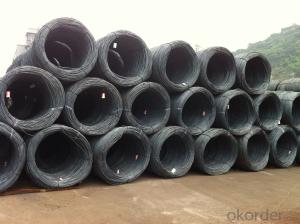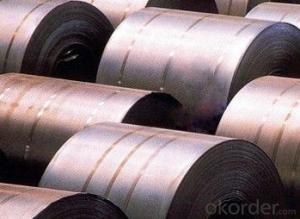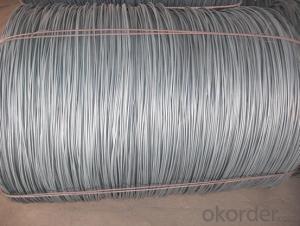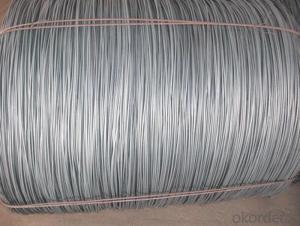Hot rolled steel wire rod 5.5mm-14mm SAE1006-1018B
- Loading Port:
- Tianjin
- Payment Terms:
- TT OR LC
- Min Order Qty:
- 25 m.t.
- Supply Capability:
- 1000000 m.t./month
OKorder Service Pledge
OKorder Financial Service
You Might Also Like
WIRE ROD Details:
| Minimum Order Quantity: | m.t. | Unit: | m.t. | Loading Port: | |
| Supply Ability: | m.t./month | Payment Terms: | TT OR LC |
Product Description:
Steel Grade: Q195 Standard: ASTM, GB
Diameter: 5.5mm, 6.5mm, 7mm,8mm,9mm,10mm,12mm,14mm
6.5mm can be drawing into 2mm/8.0mm can be drawing into 3mm
Type: Drawn Wire in Coil, each coil weight about 2MT
Brand Name: N-RIVER Place of Origin: Hebei, China
Chemical Composition:
Please kindly find our chemistry of our material based on Q195 as below for your information
Trademark | Rank | Chemical composition (quality score) % | |||||
C | Si | Mn | S | P | |||
| ≤ |
| ≤ | ≤ | |||
Q195 |
| 0.06-0.12 | 0.30 | 0.25 | 0.050 | 0.045 | |
Trademark | Rank | Pulling Test | |||||
Bend PointΔs/Mpa | Tensile Strength | Elongation Ratioδ5% | |||||
Thickness (Diameter) /MM | Thickness (Diameter) /MM | ||||||
≤16 | 16-40 | ≤16 | 16-40 | ||||
≥ | ≥ | ||||||
Q195 |
| 195 | 185 | 315-390 | 33 | 32 | |
Usage and Applications of Wire Rod Q195:
After hot-rolled the products shaped into coil and delivery as finished product, including round, square, rectangular, hexagonal and so on. Since most of the products are round, it is generally called wire rod. Carbon steel wire rod is widely used in construction and manufacturing. Carbon steel wire rod is mainly used for reinforcement of reinforced concrete and welded structure or reprocessed (roberts , nail, etc.) materials, especially used to produce wire drawing, welding electrode, nails, spring, electronic, precise machinery parts and so on
- Q:How is steel wire rod used in the manufacturing of wire mesh for concrete reinforcement?
- Steel wire rod is used in the manufacturing of wire mesh for concrete reinforcement by being formed into a grid-like pattern. This wire mesh is then embedded within the concrete to provide added strength and stability, preventing cracking and ensuring durability. The steel wire rod acts as a reinforcement, distributing the load and increasing the overall structural integrity of the concrete.
- Q:How is the steel wire rod market affected by mergers and acquisitions?
- The steel wire rod market can be significantly affected by mergers and acquisitions. When companies merge or acquire other companies in the industry, it often leads to consolidation and concentration of market share. This can result in increased pricing power, reduced competition, and a more streamlined supply chain. Additionally, mergers and acquisitions can also lead to the integration of complementary technologies and expertise, which may enhance the overall efficiency and innovation in the market. However, it is important to note that such transactions require regulatory approvals and can lead to potential challenges in terms of market competition and fair pricing practices.
- Q:What are the different types of steel wire rod surface defect detection and analysis tools?
- There are several types of steel wire rod surface defect detection and analysis tools available. Some common ones include visual inspection tools, such as magnifying glasses or microscopes, which allow for manual detection of surface defects. Additionally, there are automated inspection systems that use technologies like eddy current testing, ultrasonic testing, or magnetic particle inspection to detect and analyze defects in steel wire rod surfaces. These tools help ensure the quality and integrity of the steel wire rod products.
- Q:How is the dimensional accuracy of steel wire rod ensured?
- The dimensional accuracy of steel wire rod is ensured through a series of manufacturing and quality control processes. Firstly, the steel wire rod is produced using a continuous casting or hot rolling method, where the dimensions are closely monitored and controlled. This initial process ensures that the diameter and shape of the wire rod are within the desired tolerances. Once the wire rod is formed, it undergoes various mechanical treatments such as drawing, annealing, and cooling. These processes further refine the dimensions and improve the mechanical properties of the wire rod. Drawing involves pulling the wire rod through a series of dies with progressively smaller diameters, which helps in achieving the desired diameter with high precision. During the manufacturing process, regular inspections and measurements are carried out to ensure the dimensional accuracy of the wire rod. This includes using advanced measurement techniques such as laser-based measuring systems or optical scanners to check the diameter, roundness, and surface quality of the wire rod. Additionally, quality control procedures are implemented to ensure that the wire rod meets the required dimensional standards. This involves taking samples at regular intervals and measuring their dimensions to verify compliance with the specified tolerances. Any deviations from the desired dimensions are identified and appropriate corrective actions are taken to maintain the dimensional accuracy. Overall, the dimensional accuracy of steel wire rod is ensured through a combination of precise manufacturing techniques, mechanical treatments, regular inspections, and quality control procedures. These measures guarantee that the wire rod meets the dimensional requirements for its intended applications.
- Q:What are the safety considerations when handling steel wire rod?
- Some safety considerations when handling steel wire rod include wearing protective gloves and eyewear to prevent cuts and potential eye injuries. It is also important to use proper lifting techniques and equipment to avoid strains or back injuries. Additionally, individuals should be cautious of sharp edges and ensure that the wire rod is stored and transported in a secure manner to prevent accidents or damage.
- Q:How are steel wire rods used in the production of welding electrodes?
- Steel wire rods are used in the production of welding electrodes as they serve as the core material for the electrode. The steel wire rods are manufactured with specific chemical composition and mechanical properties to ensure strength and durability. They are then further processed to form the electrode's outer coating, which provides additional properties such as arc stability, slag removal, and alloying elements. Overall, steel wire rods are essential for the production of welding electrodes as they form the backbone of the electrode, enabling efficient and effective welding operations.
- Q:How does steel wire rod compare to other materials in terms of strength and durability?
- Steel wire rod is widely regarded as one of the strongest and most durable materials available in the market. When compared to other materials, such as aluminum or copper, steel wire rod boasts superior strength and durability. Firstly, steel wire rod has an exceptional tensile strength, meaning it can withstand significant pulling forces without breaking or deforming. This strength is crucial in applications where the material is subjected to heavy loads or high-stress conditions. In comparison, aluminum or copper wire rod would typically have lower tensile strength, making them more susceptible to deformation or breakage under similar circumstances. Additionally, steel wire rod exhibits remarkable durability due to its resistance to corrosion, wear, and fatigue. Steel has a natural ability to withstand adverse environmental conditions, making it suitable for various harsh environments, including outdoor or marine applications. On the other hand, materials like aluminum or copper are more prone to corrosion and wear, which can compromise their strength and longevity over time. Moreover, steel wire rod offers excellent structural integrity, allowing it to maintain its strength and shape even when exposed to extreme temperatures or heavy mechanical stress. This characteristic makes steel wire rod highly suitable for demanding applications where safety and reliability are paramount, such as construction, automotive, or aerospace industries. Comparatively, materials like aluminum or copper may experience greater deformation or loss of strength under similar conditions. In conclusion, steel wire rod surpasses other materials in terms of strength and durability. Its exceptional tensile strength, resistance to corrosion and wear, as well as its ability to withstand extreme conditions, make it the preferred choice in numerous industries. Whether it is used for structural purposes, reinforcement, or support, steel wire rod consistently delivers superior performance, ensuring reliability and longevity in various applications.
- Q:What are the main factors influencing the choice of steel wire rod packaging?
- The main factors influencing the choice of steel wire rod packaging include the weight and size of the wire rod, the required protection and safety during transportation, the storage conditions, the specific industry requirements, and the cost-effectiveness of the packaging solution.
- Q:How is steel wire rod used in the production of wire for musical instruments?
- The production of wire used for musical instruments requires steel wire rod, which serves as an essential component. Through a series of manufacturing processes, the steel wire rod is transformed into the desired wire form. To begin with, the steel wire rod serves as the starting point for creating wire of different gauges needed for various musical instruments. It is typically made from high-quality steel with specific chemical compositions and mechanical properties that ensure the desired strength and durability of the final wire product. Once obtained, the steel wire rod undergoes several processes such as drawing, annealing, and tempering to achieve the desired characteristics. Drawing involves pulling the wire rod through dies, reducing its diameter and increasing its length. This process refines the wire's surface finish and enhances its tensile strength. Annealing is another crucial step that includes heating the wire to a specific temperature and slowly cooling it. This process relieves internal stresses, improves the wire's ductility, and enhances its ability to resonate when used in musical instruments. Following annealing, the wire may undergo further processes like tempering. This involves heating the wire to a lower temperature and rapidly cooling it to achieve specific hardness and springiness. This step is crucial in creating wire with the desired flexibility and responsiveness required for different musical instruments. Once the wire is produced, it can be utilized in the construction of various musical instruments. For instance, steel wire is commonly used in guitar strings, piano wires, and brass instruments. Careful selection of the wire's gauge and composition ensures the desired pitch, tonal quality, and playability of the instrument. In conclusion, steel wire rod is a vital component in the production of wire for musical instruments. It undergoes various manufacturing processes to create wires of different gauges, strengths, and tonal characteristics. These wires are then used in the construction of diverse musical instruments, contributing to the creation of beautiful sounds and melodies.
- Q:What are the safety precautions to be followed while working with steel wire rod?
- When working with steel wire rods, it is important to follow several safety precautions to ensure the well-being of yourself and others. Here are some safety measures that should be followed: 1. Personal Protective Equipment (PPE): Always wear appropriate PPE such as safety glasses, gloves, and steel-toed boots to protect yourself from potential hazards. 2. Training and Knowledge: Ensure that you have received proper training and have a good understanding of the equipment, tools, and procedures for working with steel wire rods. 3. Secure Work Area: Keep the work area clean and well-organized. Remove any obstacles or tripping hazards to prevent accidents. 4. Handling and Storage: Handle steel wire rods with care to avoid injuries. Lift and carry them using proper lifting techniques and equipment. Store them in a designated area away from walkways to prevent accidental contact. 5. Inspection: Regularly inspect the wire rods for any signs of damage, such as sharp edges or protrusions, before and during use. Replace any defective rods immediately. 6. Fire Safety: Steel wire rods can generate sparks during cutting or welding processes. Ensure that the work area is free from flammable materials and have appropriate fire extinguishing equipment readily available. 7. Cutting and Grinding: When cutting or grinding steel wire rods, use appropriate tools and follow safety procedures. Wear a face shield or goggles to protect your eyes from flying debris. 8. Secure Fastening: Ensure that the wire rods are securely fastened during installation or use to prevent them from becoming loose or falling. 9. Communication and Signage: Clearly communicate with others in the vicinity about the work being performed. Use warning signs and barricades to prevent unauthorized access to the work area. 10. Emergency Preparedness: Familiarize yourself with emergency procedures and know the location of emergency exits, first aid kits, and safety showers in case of accidents or injuries. By following these safety precautions, you can minimize the risks associated with working with steel wire rods and create a safer working environment for yourself and those around you.
1. Manufacturer Overview |
|
|---|---|
| Location | |
| Year Established | |
| Annual Output Value | |
| Main Markets | |
| Company Certifications | |
2. Manufacturer Certificates |
|
|---|---|
| a) Certification Name | |
| Range | |
| Reference | |
| Validity Period | |
3. Manufacturer Capability |
|
|---|---|
| a)Trade Capacity | |
| Nearest Port | |
| Export Percentage | |
| No.of Employees in Trade Department | |
| Language Spoken: | |
| b)Factory Information | |
| Factory Size: | |
| No. of Production Lines | |
| Contract Manufacturing | |
| Product Price Range | |
Send your message to us
Hot rolled steel wire rod 5.5mm-14mm SAE1006-1018B
- Loading Port:
- Tianjin
- Payment Terms:
- TT OR LC
- Min Order Qty:
- 25 m.t.
- Supply Capability:
- 1000000 m.t./month
OKorder Service Pledge
OKorder Financial Service
Similar products
New products
Hot products
Hot Searches
Related keywords






























